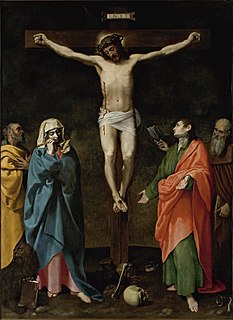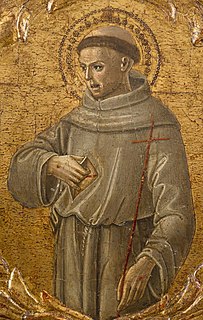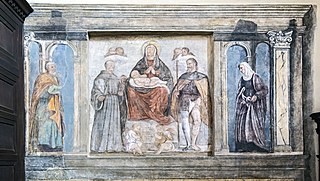
Girolamo Da Carpi was an Italian painter and decorator who worked at the Court of the House of Este in Ferrara. He began painting in Ferrara, by report apprenticing to Benvenuto Tisi ; but by age 20, he had moved to Bologna, and is considered a figure of Early Renaissance painting of the local Bolognese School.

Girolamo Francesco Maria Mazzola, also known as Francesco Mazzola or, more commonly, as Parmigianino, was an Italian Mannerist painter and printmaker active in Florence, Rome, Bologna, and his native city of Parma. His work is characterized by a "refined sensuality" and often elongation of forms and includes Vision of Saint Jerome (1527) and the iconic if somewhat anomalous Madonna with the Long Neck (1534), and he remains the best known artist of the first generation whose whole careers fall into the Mannerist period.

Lorenzo Costa was an Italian painter of the Renaissance.

The Accademia di San Luca is an Italian academy of artists in Rome. The establishment of the Accademia de i Pittori e Scultori di Roma was approved by papal brief in 1577, and in 1593 Federico Zuccari became its first principe or director; the statutes were ratified in 1607. Other founders included Girolamo Muziano and Pietro Olivieri. The Academy was named for Luke the Evangelist, believed to be the patron saint of painters.
Girolamo Pieri Pecci Ballati Nerli, was an Italian painter who worked and travelled in Australia and New Zealand in the late 19th century influencing Charles Conder and Frances Hodgkins and helping to move Australian and New Zealand art in new directions. His portrait of Robert Louis Stevenson in the Scottish National Portrait Gallery Edinburgh, is usually considered the most searching portrayal of the writer.

Bartolomeo Cesi was an Italian painter and draftsman of the Bolognese School. He made easel paintings as well as frescoes. He is known mainly for his religious paintings but he also painted portraits and mythological scenes.

Francesco Costanzo Catanio, was a painter of the Italian Baroque period, born and mainly active in Ferrara. He was variously known as Catanio, Cattani, Cattaneo, or Cattanio, sometimes without the forename Francesco.
Events from the year 1566 in art.

Felice Riccio (1542–1605) was an Italian painter of the late-Renaissance period, born and mainly active in Verona. He is also known as il Brusasorci or Brusasorzi or Felice Brusasorci. He was the son of the painter Domenico Riccio. He painted a Deposition for the church of Tombazosana in the town of Ronco all'Adige. He painted a canvas for the Sanctuary-Basilica of Santa Maria della Pace in Verona.

Claudio Ridolfi (1560–1644), also known as Claudio Veronese, was an Italian painter of the Renaissance period.

Mauro Antonio Tesi, or, as he is sometimes called, after the name given him by his patron and admirer, Francesco Algarotti, "Il Maurino", was an Italian painter of the late-Baroque period, active mainly in Bologna. He is also considered an early proponent of the Neo-classical style.

Girolamo da Treviso, also known as Girolamo di Tommaso da Treviso the Younger and Girolamo Trevigi, was an Italian Renaissance sculptor and painter in Henry VIII's court in England.

Girolamo da Santacroce was a 16th-century Italian painter of the Renaissance period, active mainly in Venice and the Venetian mainland.

Benvenuto di Giovanni, also known as Benvenuto di Giovanni di Meo del Guasta was an Italian painter and artist known for his choral miniatures, pavement designs, and frescoes. Working chiefly in Siena, he was first recognized to be working as an artist in 1453 and continued his work nearly until his death in approximately 1518. During his lifetime, he was influenced by many various artists and in the 1480s, Benvenuto's style changed drastically.

Counter-Maniera or Counter-Mannerism is a term in art history for a trend identified by some art historians in 16th-century Italian painting that forms a sub-category or phase of Mannerism, the dominant movement in Italian art between about 1530 and 1590. Counter-Maniera or Counter-Mannerism reacted against the artificiality of the second generation of Mannerist painters in the second half of the 16th century. It was in part due to artists wishing to follow the vague prescriptions for clarity and simplicity in art issued by the Council of Trent in its final session in 1563, and represented a rejection of the distortions and artificiality of high Mannerist style, and a partial return to the classicism and balance of High Renaissance art, with "clarity in formal order and legibility in content".

Girolamo Alibrandi (1470-1524), was an Italian painter, born and active in Sicily, called the Raphael of Messina.
Girolamo Amalteo was a 16th-century Italian artist, the brother of Pomponio Amalteo.
Giovanni Breviglieri was an Italian painter, active in Bologna painting history and sacred subjects. It is notable that biographers refer to the painter as dying with odor of sanctity or in a concept of piety, underscoring a reputation as a blessed man.

Girolamo Tessari, also called Gerolamo Tessari or Girolamo dal Santo, was an Italian painter, active in a Renaissance style in his native city of Padua.
Carlo Mazza (1704-1777) was an Italian painter.















